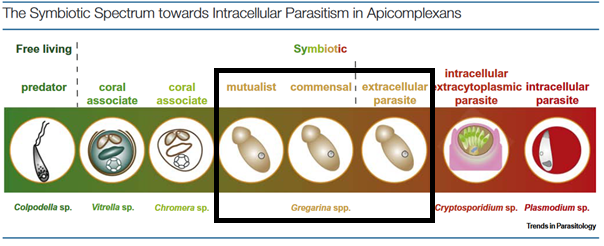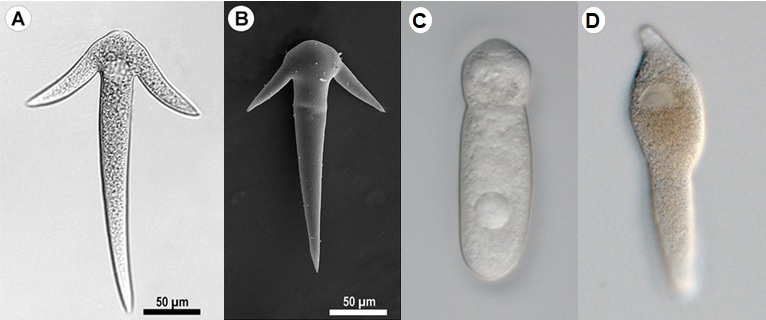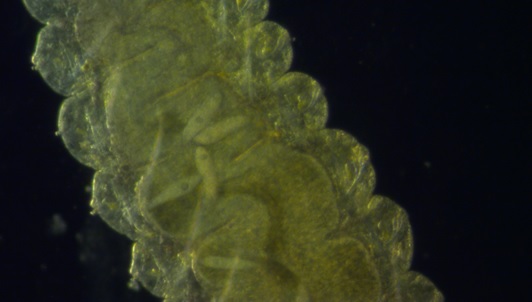For this month’s group, I’m presenting you one of the three groups I am working with here at CEG group, the gregarines (Gregarisina, Apicomplexa). I got to know this group during my PhD research and I grew fond of them as study system for marine symbiosis.
Gregarines are a diverse group of single-celled protists that infect mostly invertebrates, especially arthropods, annelids, and mollusks. They can be found from intestines and other body cavities of their hosts. They are an ancestral group in the phylum Apicomplexa, which is famous for notorious disease-causing protists such as Plasmodium (malaria), Toxoplasma (toxoplasmosis) and Cryptosporidium (cryptosporidiosis), just to name a few. The most fascinating thing about gregarines is that even though they live inside a host and use the hosts resources for their own growth and reproduction, in most cases it is not clear if they actually harm their hosts at all (Rueckert et al. 2019)(Figure 1). Are they parasites or perhaps even beneficial to their hosts? The effects of these protists on their hosts fitness are also much less studied than their human and livestock infecting relatives. In my research, I’m interested in finding out the role these tiny symbionts have, so I thought it would be more than fair to give this group a little attention in the CEG group blog.

Figure 1. Illustration of the different interactions among apicomplexans from Rueckert et al. 2019. Interactions between gregarines and their hosts are highlighted inside the black box. https://www.cell.com/trends/parasitology/fulltext/S1471-4922(19)30164-3
It has been estimated that every invertebrate species hosts at least one gregarine species. Therefore, the diversity of gregarines should be enormous! In fact, gregarines have been identified as the most abundant group of apicomplexans in many recent studies using metabarcoding of environmental samples (e.g. Mahe et al. 2017). However, their true diversity remains a mystery mostly due to low economic importance of most of their hosts. To date, some 1600 species have been described mostly from terrestrial insects.
The majority of gregarines are monoxeous, meaning they complete their life cycle inside one host. A host gets the infection by ingesting gregarine oocysts accidentally while feeding. After being swallowed by a host, the oocysts release the actual infectious stages of gregarines, sporozoites, that then migrate to the appropriate part of the host body they can feed and grow. The next life stage is called a trophozoite, which in many species can grow quite large. Trophozoite morphology (Figure 2) has also been used to distinguish different gregarine species from each other and some of them have quite peculiar morphologies. One funny looking gregarine is the anchor-shaped Ancora sagittata found in the polychaete worm Capitella capitata. Having reached maturity, trophozoites pair up for sexual reproduction in a process called syzygy and develop into gamonts surrounded by a gametocyst wall. Each gamont divides into hundreds of gametes that fuse into zygotes, which later develop into highly persistent oocysts. These oocysts are then released into the environment usually with host feces and await encounter with new host.

Figure 2. Light (A) and electron microscopy (B) of Ancora sagittata from Simdyanov et al. 2017. More typical gregarine trophozoite shapes (C) septate eugregarine and (D) Lankesteria cystodytae (both pictures Sonja Rueckert http://tolweb.org/Gregarina/124806 )
Another interesting feature of gregarines, in my opinion is, that despite being single-celled and lacking the obvious morphological features for movement, such as cilia or flagella, gregarines can move by gliding or bending and even change the direction they are going to! They can do so by using a specialized protein complex called actin and myosin complex. Below is a cool video of a pair of newly described marine gregarines Undularius glycerae making wave-like movements.
While gregarines are endosymbionts living inside their hosts, they are also acting as hosts themselves. A group of microsporidian parasites called metchnikovellids use gregarines that infect marine worms as their hosts. This phenomenon is called hyperparasitism and I will talk about it in another blog post in the future. Stay tuned!
Further reading
Mahé F., de Vargas C., Bass D., et al. (2017). Parasites dominate hyperdiverse soil protist communities in Neotropical rainforests. Nat Ecol Evol, 1, 0091. https://doi.org/10.1038/s41559-017-0091
Odle E., Riewluang S., Ageishi K., Kajihara H. & Wakeman, K.C. (2024). Pacific marine gregarines (Apicomplexa) shed light on biogeographic speciation patterns and novel diversity among early apicomplexans. Eur. J. Protistol. 94, 126080. https://doi.org/10.1016/j.ejop.2024.126080.
Rueckert, Sonja I. and Brian S. Leander. 2008. Gregarina Dufour 1828. Gregarines. Version 23 September 2008. http://tolweb.org/Gregarina/124806/2008.09.23 in The Tree of Life Web Project, http://tolweb.org/
Rueckert S., Betts E.L. & Tsaousis A.D. (2019). The Symbiotic Spectrum: Where Do the Gregarines Fit? Trends Parasitol., 35(9):687-694. doi: 10.1016/j.pt.2019.06.013.
Simdyanov T.G., Guillou L., Diakin A.Y., Mikhailov K.V., Schrével J., Aleoshin V.V. (2017). A new view on the morphology and phylogeny of eugregarines suggested by the evidence from the gregarine Ancora sagittata (Leuckart, 1860) Labbé, 1899 (Apicomplexa: Eugregarinida) PeerJ 5:e3354 https://doi.org/10.7717/peerj.3354
![]()
